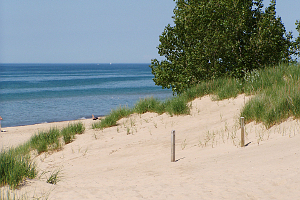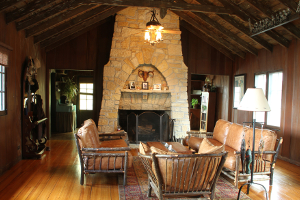
Photo above: Entrance to the beach at Indiana Dunes National Park. Right: Sunset over Lake Michigan at Indiana Dunes. Photos courtesy National Park Service.

Indiana Dunes National Park
In some ways, it's an incongruous location for so much nature and beauty, situated close to Gary, Indiana, and close enough to the Windy City of Chicago that you can take the Chicago and South Shore Train to the park. It's a place to camp, to spend a day on the beach, bird watch, and get a little history of the south shore of Lake Michigan, plus a World's Fair. Who'd a thunk it, but it's true. For the midwesterner who hasn't been to Indiana Dunes, take a day some time and head there. Might be one of those surprises you'll want to experience again. And as of February 2019, it's no longer a national lakeshore, but a full national park.
Click here to Sponsor the page and how to reserve your ad.

Indiana Dunes Then
Yes, a long time ago, it looked like this, with nature and beaches to explore, but the land had been claimed by industry in many parts during the days of the industry revolution as the city of Chicago and Gary grew into manufacturing towns. The park itself only dates back to 1966 in an official way, although plans to save the dunes began back in 1899 when a University of Chicago botanist, Henry Cowles, wrote about the dunes and the ecology as a place of wonder that should be saved. It didn't matter in the first years after that; by 1916 the dunes were a bustling mecca of industrial movement for firms in the glass business. After the National Park Service was established that year, talk began within the NPS that a "Sand Dunes National Park" might be a good idea. Ten years later a small portion of the dunes were saved as Indiana Dunes State Park.
In 1935 after a two year stint in the innovative home design section of the Chicago Century of Progress Exposition, five homes were transported to the lakeshore to be part of an innovative housing community. When the park was established in 1966, they were included in the park, adding a historic element of a different nature to the landscape along the lake. Of course, they are certainly the newer of the structures that remain in the park from the past. The Chellberg Farm represents a late 19th and early 20th century farmstead of a Swedish immigrant family.
Photo above: Sand dunes at the Portage Lakefront and Riverwalk. Courtesy National Park Service. Below: Waves crashing onto the beach in the park. Courtesy National Park Service.

Indiana Dunes Now
How you choose to enjoy Indiana Dunes National Park is up to you? If you just want to put your feet in sand and Lake Michigan surf, you can head over to West Beach or one of the other locales and spend the day from sunup to sundown on a beach day. If you want to expand your nature horizons, you can head over to the Paul H. Douglas Center for Environmental Education or a trail and witness over 1,400 species of plants that grow along the shores in the same manner they did when the Potawatomis would row the boat to the same locales. There are ranger guided tours available from the Visitor Center during the summer season, with some available at other times of the year. Some are held at sunset. Now that's a pretty awesome site.
If you're there during the right time of the year, you might get to witness a birding festival, or surf classes, or perhaps a guided visit to Chellberg Farm. Yes, there's a farm.
If you're just into taking a hike, there's tons of trails throughout the fifteen thousand acres, including trails of 3.4 miles from West Beach or the Miller Woods Trail at the Environmental Center. But there's a whole lot more than that.
Beaches and Nature - There's more than dunes along the fifteen miles of shoreline included in the park. You have oak savannas, swamps, prairies, and forests. Now perhaps due to the namesake element, the dunes still rise as the most impressive, some two hundred feet high. Ask for a trail map at the Visitor Center that can take you to the scenery you might enjoy most.
Buildings and History - Yes, the Chellberg Farm and Century of Progress homes are still there. You can tour them at various times of the year and look at the World's Fair homes from the outside at others. They are now private residences so don't pry too much. There are over sixty historic structures in the park, including the notable Bailly Homestead and Good Fellow Youth Camp.
Ranger Tours - Tours are given for free by park rangers on a regular basis during the summer season. There are special tours of the Century of Progress homes at various times. These require a fee.
T-Shirts and Souvenirs

Indiana Dunes National Park T-Shirts and Souvenirs.

Indiana Dunes
Things You Should Not Miss
1. Take a ranger guided walk at sunset or take in a campground program. You'll have to check at the Visitor Center for when and where or the topics at hand, but for some reason, we like these evening programs when the day is winding down and you are too.
2. Wander into the Visitor Center and watch the film "Child of the Northwest Wind." There's also exhibits and an Artist in Residence program there, plus orientation from the staff that can help map out your itinerary.
3. Go take a hike. There are eleven different sets up trails in the park of varying difficulties, terrain, and scenery. Some have cool names; Cowles Bog Trail and Heron Rookery Trail comes first to mind, but you may have your favorite.
Photo above: Lighthouse on the lake at Indiana Dunes National Seashore. Source: National Park Service.

A poster for the 1934 edition of the Century of Progress Exposition from the Chicago Tribune.

Get Baseball History and Books at Stat Geek Baseball, including Baseball's Best 150.







